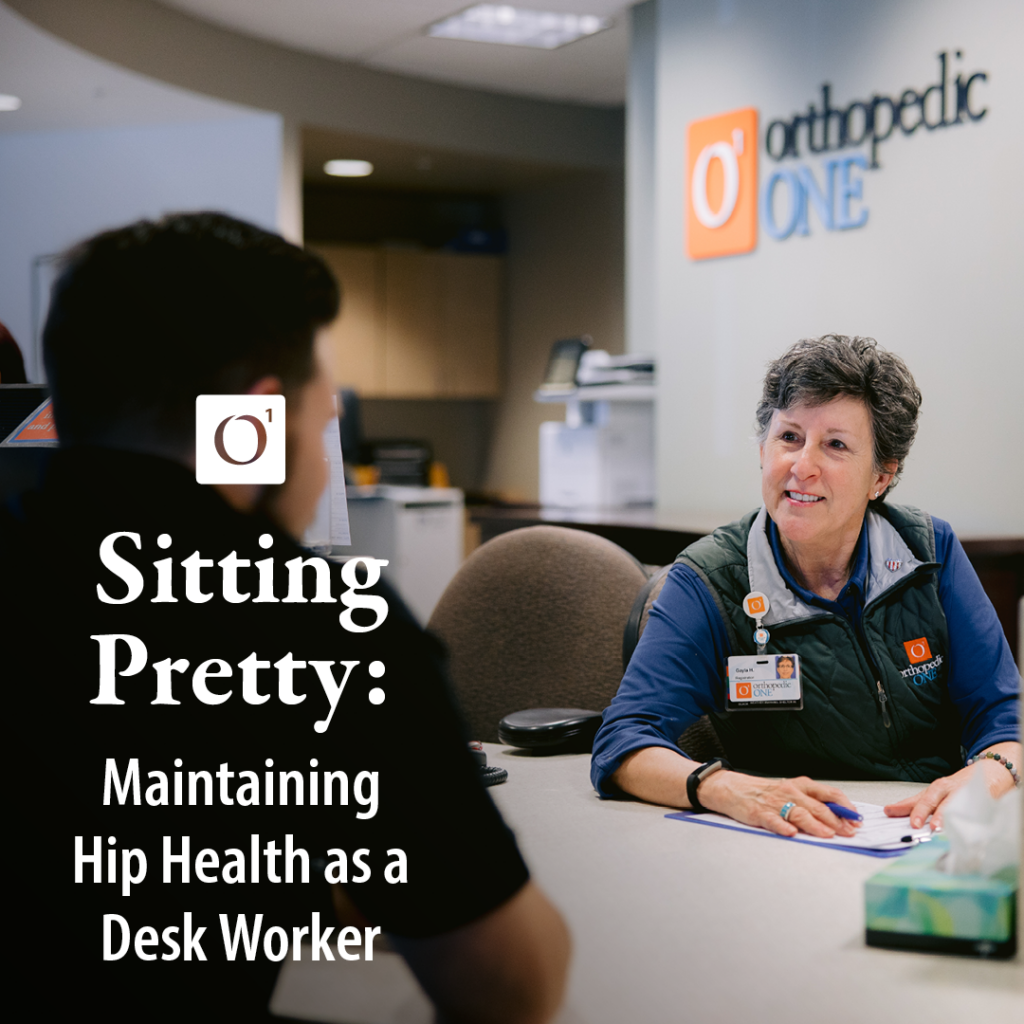Sitting Pretty: Maintaining Hip Health as a Desk Worker
Your hips are the foundation of your body’s mobility and play a crucial role in your overall musculoskeletal health. At Orthopedic ONE, we often see patients suffering from hip flexor or lower back pain—especially those who spend most of their day seated at a desk. If you’re an office worker, taking time to care for your hips can make a world of difference for your overall comfort and well-being. Prolonged sitting can take a toll on your hips, but with targeted exercises and simple adjustments, you can maintain their health and mobility.

What Working at a Desk Does to Your Hips
The modern lifestyle includes a lot of sitting. Research shows that a significant portion of U.S. adults spend about 70% of their waking hours sitting, 30% in light activities, and little to no time exercising (National Library of Medicine). Over time, this behavior can affect hip health and mobility, contributing to a range of issues, including:
- Tight hip flexors: Prolonged sitting keeps your hip flexor muscles in a shortened position, which can lead to tightness over time. This tightness can restrict your range of motion and lead to discomfort.
- Hip and lower back pain: Pain in these areas often stems from more than just tight hip flexors. Weak gluteal muscles, which provide stability and support for the hips, can also play a role. When your glutes aren’t doing their job, your lower back and hip flexors have to compensate, leading to strain and pain.
- Long-term complications: Over time, constant sitting and poor hip health can contribute to more serious conditions. Tight hip flexors and weak glutes can create muscle imbalances, increasing the likelihood of leg or whole-body injuries, such as strains or falls. Additionally, chronic hip and back discomfort can exacerbate conditions like arthritis, making movement increasingly difficult and painful as joints become stiffer.
The good news? There are steps you can take to counteract these effects, prevent discomfort, and keep your hips healthy.
Orthopedic ONE: Your Partner in Hip Health
If you’re dealing with mild hip pain, or simply want to prevent discomfort, incorporating stretches and exercises into your daily routine can make all the difference. Here are a few effective stretches to get started—but remember, every body is unique so consult with a medical provider before starting a new routine.
- Kneeling hip flexor stretch
- Kneel on one knee with your other foot flat on the floor in front of you.
- Shift your weight forward slightly while keeping your back straight.
- Hold for 20-30 seconds on each side.
- Pigeon pose
- From a kneeling position, bring one leg forward, placing your shin across your body.
- Extend your other leg straight behind you.
- Lower your torso over the bent leg for a deeper stretch. Hold for 20-30 seconds on each side.
- Seated figure-four stretch
- Sit in a chair with your feet flat on the floor.
- Cross one ankle over the opposite knee.
- Gently press down on the crossed knee to deepen the stretch. Hold for 20-30 seconds on each side.
- Butterfly stretch
- Sit on the floor with your feet together and knees bent outward.
- Gently press your knees to the floor with your elbows. Hold for 20-30 seconds.
- Bridge exercise
- Lie on your back with your knees bent and feet flat on the floor.
- Lift your hips toward the ceiling, squeezing your glutes at the top.
- Lower back down slowly. Repeat 10-15 times.
Additionally, swimming is an excellent low-impact exercise that helps loosen tight hip flexor muscles while increasing overall mobility.
Make Your Workspace Work for You
Improving the ergonomics of your workspace can significantly reduce the strain on your hips and prevent discomfort. Consider the following adjustments:
- Adjust your chair: Ensure your chair is at the right height so your knees are at a 90-degree angle and your feet rest flat on the floor.
- Use a lumbar support cushion: This helps maintain the natural curvature of your spine and reduces strain on your lower back and hips.
- Position your screen and keyboard: Keep your computer screen at eye level and your keyboard at a height where your elbows are bent at a 90-degree angle.
- Take movement breaks: Stand, stretch, or walk around every 30 minutes to avoid prolonged periods of sitting.
The Bottom Line
Your hips are a powerhouse of your body and keeping them healthy is essential—especially if you spend most of your day at a desk. By incorporating daily stretches, staying active, and making ergonomic adjustments to your workspace, you can prevent discomfort and maintain optimal hip mobility. For ongoing or severe pain, our experts at Orthopedic ONE are here to help with personalized care and treatment plans. Your hips deserve the best—start giving them the attention they deserve today.